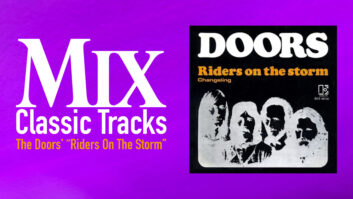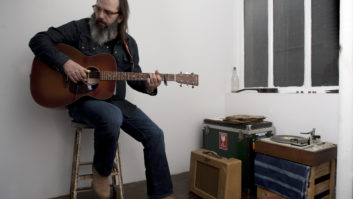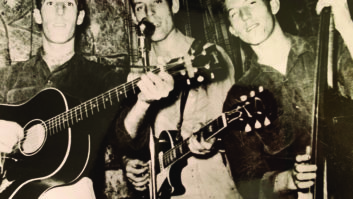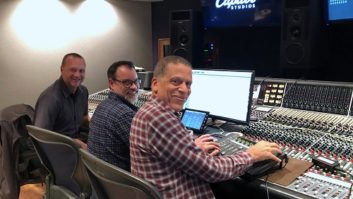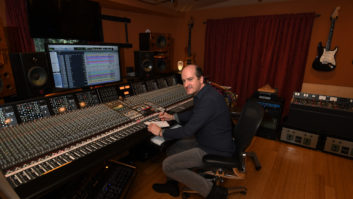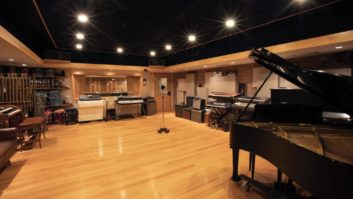NORTH HOLLYWOOD, CA—Walking into the lobby of Valentine Recording Studios, located on Laurel Canyon Blvd. in L.A.’s San Fernando Valley, visitors take a step back in time. Unused since the early 1980s, the facility has recently been reopened by the family of the original owner. Perfectly preserved, the facility offers no visual cues to suggest that more than three decades have passed since it last hosted a recording session.
A true-life time capsule of Sixties and Seventies recording studio gear, furnishings and vibes, Valentine Studios in North Hollywood was brought back to life by (l-r) Nicolas Jodoin, Brittany Barsony and Justin Barsony, seen here in Studio A with a 1975 custom MCI JH-416 console. The studio was originally owned by Jimmy Valentine, a Chicagoan who later moved to Washington, DC, then relocated to Los Angeles to pursue a career as an audio engineer, initially working at Capitol and NBC. He subsequently acquired a former doctor’s office in North Hollywood and went into business for himself, but eventually got sidetracked into the car parts business and closed the facility. Now, Valentine’s grandson, Justin Barsony, and his wife Brittany, have reopened the studio with help from French Canadian Nic Jodoin a 15-year veteran producer and engineer whose credits includes BRMC, Nightbeats and Nick Waterhouse.

According to Justin Barsony, Valentine “moved out here in late 1949 and built a home studio. He recorded there for about 13 years, then bought this building in 1963.”
In 1972, Valentine and his wife’s Ford Thunderbird was stolen. They replaced it with a Metropolitan and, after discovering how hard it was to find spare parts, Valentine started a new business, the Metropolitan Pit Stop, restoring and repairing the ultra-compact cars, running it in tandem with the studio. The shop still occupies the building next door.
Valentine, who was used to recording three-hour sessions with artists such as Stan Kenton, Bing Crosby, Frankie Avalon and Burl Ives, soon lost interest in recording as rock ’n’ roll music and its associated lifestyle led to projects stretching out over days and weeks. The car shop flourished, so he started using the facility’s large tracking room for storage, but not before tackling projects with a few newer artists such as the Beach Boys and Frank Zappa.
Barsony has been trying to get a restoration project off the ground for over 10 years, he says. “It was overwhelming, not knowing many people in the business. Where do we even start? So we hooked up with Nic and said, let’s do this.” Happily, the parts storage was kept pretty tidy, he reports, and apart from some water damage from a roof leak five years ago, all the facility needed was a really good cleaning to get it operational again.
At the front of the facility, Studio B is a time capsule of the 1960s, with a 12-channel Universal Audio 610A console taking pride of place on the Formica-covered desk. The control room houses a rack of Pultec, Hycor, UA 177 and other outboard equipment, plus Ampex 356 and 440 and Stephens 811C tape recorders custom-built into cabinets by the technically proficient Valentine, who was certified by Ampex. The small live room, with its original yellow drapes and mood lighting, was popular for voiceover work—Mel Blanc was a regular visitor—and is now being offered as a songwriting space as well as for overdub sessions.
At the rear of the building, Studio A, which doubled the facility’s footprint when it was completed in the mid-sixties, was upgraded in 1975 with a custom MCI JH-416 console, later expanded to 32 inputs, with an eight-channel Flickinger sidecar. Outboard devices from the era include units by Quad Eight and Spectra Sonics, a UA 175 limiter, a Flickinger limiter and a B revision UA 1176. The room, which is configured for quadraphonic mixing and features 1970s orange shag carpet with golden velvet wall treatments, appeared in an Altec ad at the time, says Jodoin. The monitors, now in different cabinets, are still in use. At the back of the room is an MCI JH-114 tape machine.
Four Altec Voice of the Theater speakers hang in a line above the control room window in the tracking space, which is large enough to house a small orchestra or jazz big band. The mic collection includes multiple RCA 77 and Sony C-37A models as well as Electro-Voice and Sennheiser examples from the period.
Jodoin believes Valentine invented the first gobos to include a window. Billboard’s June 22, 1968 edition confirms, “Valentine Recording Studios in North Hollywood has devised see-through baffle separations. Placed on wheels, the baffles can be adjusted to any height or size to avoid visual impairment.”
Barsony and Jodoin have been encouraging new clients to record together in the space. “You can have the drummer playing there,” says Jodoin, pointing to the corner of the room, “and we could be talking here; the drums barely bleed [into the other mics].”
Valentine, who reportedly kept meticulous documentation, wired every room in the building together. “You can have a band recording here, use the 610 as mic pres and bring those back into the MCI,” says Jodoin.
During the clean-up, Jodoin spotted a patchbay label that said “chambers.” “We were looking everywhere, but didn’t think of looking up,” he laughs. Situated above a rear hallway, the two chambers had also become storage units.
One room remains to be restored—Studio C, which is piled high with enough parts to build several Rek-O-Kut and Presto disc cutting lathes. “When he bought stuff, he didn’t just buy one,” says Barsony, “he would buy three of everything. People thought he was crazy, but it’s great for us now.”
Valentine Recording Studios
valentinerecordingstudios.com


